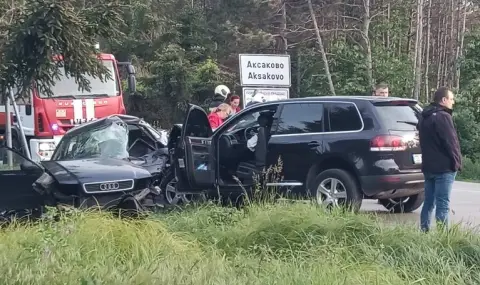Road Safety Institute experts examined the traffic situation of the NSO car crash site using Google Maps.< /p>
According to the preliminary data and photos, the accident happened at the entrance to Varna from Aksakovo, where "Dobrudzha" street intersects with road 29, right next to "Trafik" car wash. The same signs and directional signs are clearly visible in the photos.
From the side of "Dobrudzha" street there is actually a stop sign that must be obeyed by drivers due to the heavy traffic on the other road, which has no dividing line.
Road 29 at this place is a right turn (if we follow the direction of movement of the NSO car) with a relatively large diameter of about 400-600 m. Regardless of this, however, the turn is quite sharp, so much so that when cars are moving towards Varna, the first opportunity for drivers to see a stopped car at a stop sign (as well as for the drivers themselves to have a direct line of sight to each other) is about 140 m from the intersection (see purple arrows in the illustration). There is lush vegetation, signs and a crooked road.
In traffic accidents, as well as the design of roads and cars, the laws of physics are followed, and there are formulas for measuring stopping distance, road traction, etc. One of them, for stopping distance, can be derived with the formula S=V *V/(2fg) in meters where:
S – braking distance (m)
V – movement speed (in m/s)
f – coefficient of friction
g – the earth's gravity, equal to 9.81 m/sec
Since the speed is to the second degree, the stopping distance is not proportional to it. At 2 times the speed, the stopping distance is 4 times greater. And according to this formula, and assuming that we have dry asphalt, the braking distance at 60 km/h e 15-18 is 15-18 meters, but at 120 km/h it is over 60-65, and with dry asphalt and ideal tires and brakes. Adding the reaction time of the driver when he sees someone on the road, which is 1-2 seconds, and it turns out that the distance of 130 m may be enough to stop if he is driving at 60 km/h, but it will is completely inaccessible at a speed over 100. With wet pavement, for example, the braking distance can reach 200 m.
We add the following to the factors here
1. In addition to the fact that the turn is right and does not provide good visibility, there are also several large signs and trees that further complicate the visibility between the two drivers. I.e. if under optimal conditions of maximum visibility between the two drivers of 137-140 m, here things are further complicated and it is possible that the injured driver stopped at a stop sign, waited, and when he started, did not see another car on the left at all .
2. In 2-4 seconds, as long as it would take a car from a stopped position to enter the lane, a car at 60 km/h would cover 50 meters, but a car moving over 110-120 - would cover over 100 m., i.e. is. practically it is almost impossible to stop and avoid a crash.
That is why there should be a limit of 50-60 km/h, because even every single driver on "Dobrudzha" Street to stop at the stop sign, then if another car is moving at more than 90 km/h - the probability that he will see too late entering the lane from road 29 is very high.
The competent authorities will have to clarify the details, who stopped, who drove how much, whether these signs further obstructed visibility, etc. This research is only to warn other drivers that even stopping at a Stop sign, not is always a guarantee of safety. It doesn't matter if someone had their lights on or not - with a sharp turn and low visibility, there is always a risk that someone will jump out at the last moment.
According to all the analyses, it is clear from the look of the crushed cars that the speed was high. If this is the case, where exactly were Kiril Petkov and company in a hurry, and why did they not stop the driver from driving unreasonably fast?
Did you know that in the United States and other western countries there are laws that punish even passengers if they are accomplices and encourage the driver to drive drunk or fast (Encouraging Speeding).
